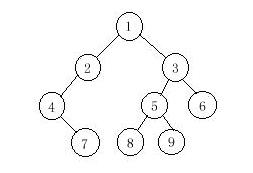Description
A binary tree is a finite set of vertices that is either empty or consists of a root r and two disjoint binary trees called the left and right subtrees. There are three most important ways in which the vertices of a binary tree can be systematically traversed or ordered. They are preorder, inorder and postorder. Let T be a binary tree with root r and subtrees T1,T2.
In a preorder traversal of the vertices of T, we visit the root r followed by visiting the vertices of T1 in preorder, then the vertices of T2 in preorder.
In an inorder traversal of the vertices of T, we visit the vertices of T1 in inorder, then the root r, followed by the vertices of T2 in inorder.
In a postorder traversal of the vertices of T, we visit the vertices of T1 in postorder, then the vertices of T2 in postorder and finally we visit r.
Now you are given the preorder sequence and inorder sequence of a certain binary tree. Try to find out its postorder sequence.

In a preorder traversal of the vertices of T, we visit the root r followed by visiting the vertices of T1 in preorder, then the vertices of T2 in preorder.
In an inorder traversal of the vertices of T, we visit the vertices of T1 in inorder, then the root r, followed by the vertices of T2 in inorder.
In a postorder traversal of the vertices of T, we visit the vertices of T1 in postorder, then the vertices of T2 in postorder and finally we visit r.
Now you are given the preorder sequence and inorder sequence of a certain binary tree. Try to find out its postorder sequence.

Input
The input contains several test cases. The first line of each test case contains a single integer n (1<=n<=1000), the number of vertices of the binary tree. Followed by two lines, respectively indicating the preorder sequence and inorder sequence. You can assume they are always correspond to a exclusive binary tree.
Output
For each test case print a single line specifying the corresponding postorder sequence.
Sample Input
9
1 2 4 7 3 5 8 9 6
4 7 2 1 8 5 9 3 6
Sample Output
7 4 2 8 9 5 6 3 1
已知二叉树的先序遍历与中序遍历,求该二叉树的后序遍历
#include<stdio.h>
#include<string.h>
#include<stdlib.h>
int n,m,i;
int rr = 0;
typedef struct node
{
int data;
node *right,*left;
}node;
node *make(int *x,int *y,int n)
{
node *pp;
int *qq;
int k;
if(n<=0)
{
return NULL;
}
pp = (node*)malloc(sizeof(node));
pp->data = *x;
for(qq=y;qq<y+n;qq++)
{
if(*qq == *x)
{
break;
}
}
k = qq - y;
pp->left = make(x+1,y,k);
pp->right = make(x+k+1,qq+1,n-k-1);
return pp;
}
void shuchu(node *t)
{
if(t == NULL)
{
return ;
}
shuchu(t->left);
shuchu(t->right);
if(rr == n-1)
{
printf("%d\n",t->data);
}
else
{
printf("%d ",t->data);
rr++;
}
}
int main()
{
node *tree;
int a[3000],b[3000];
while(scanf("%d",&n)!=EOF)
{
rr = 0;
for(i=0;i<n;i++)
{
scanf("%d",&a[i]);
}
for(i=0;i<n;i++)
{
scanf("%d",&b[i]);
}
tree = make(a,b,n);
shuchu(tree);
}
return 0;
}
#include<string.h>
#include<stdlib.h>
int n,m,i;
int rr = 0;
typedef struct node
{
int data;
node *right,*left;
}node;
node *make(int *x,int *y,int n)
{
node *pp;
int *qq;
int k;
if(n<=0)
{
return NULL;
}
pp = (node*)malloc(sizeof(node));
pp->data = *x;
for(qq=y;qq<y+n;qq++)
{
if(*qq == *x)
{
break;
}
}
k = qq - y;
pp->left = make(x+1,y,k);
pp->right = make(x+k+1,qq+1,n-k-1);
return pp;
}
void shuchu(node *t)
{
if(t == NULL)
{
return ;
}
shuchu(t->left);
shuchu(t->right);
if(rr == n-1)
{
printf("%d\n",t->data);
}
else
{
printf("%d ",t->data);
rr++;
}
}
int main()
{
node *tree;
int a[3000],b[3000];
while(scanf("%d",&n)!=EOF)
{
rr = 0;
for(i=0;i<n;i++)
{
scanf("%d",&a[i]);
}
for(i=0;i<n;i++)
{
scanf("%d",&b[i]);
}
tree = make(a,b,n);
shuchu(tree);
}
return 0;
}
第二种
#include<stdio.h>
#include<string.h>
using namespace std;
int a[1010];
int b[1010];
void dfs(int x,int y,int size,bool flag)
{
int i;
if(size==1) //如果有左子树或右子树,就直接输出
{
printf("%d ",a[x]);
return ;
}
if(size<=0) //没有左子树或右子树,则返回上层,遍历右子树或者根
return ;
for(i=0;a[x]!=b[y+i];i++);//查找根节点在中序中的位置
dfs(x+1,y,i,0); //左子树的遍历
dfs(x+i+1,y+i+1,size-i-1,0); //右子树的遍历
if(flag)//输出根节点
printf("%d\n",a[x]);//整个树的根节点
else
printf("%d ",a[x]); //一般的根节点
}
int main()
{
int n,i;
while(scanf("%d",&n)!=EOF)
{
for(i=1;i<=n;i++)
scanf("%d",&a[i]);
for(i=1;i<=n;i++)
scanf("%d",&b[i]);
dfs(1,1,n,1);
}
return 0;
}
#include<string.h>
using namespace std;
int a[1010];
int b[1010];
void dfs(int x,int y,int size,bool flag)
{
int i;
if(size==1) //如果有左子树或右子树,就直接输出
{
printf("%d ",a[x]);
return ;
}
if(size<=0) //没有左子树或右子树,则返回上层,遍历右子树或者根
return ;
for(i=0;a[x]!=b[y+i];i++);//查找根节点在中序中的位置
dfs(x+1,y,i,0); //左子树的遍历
dfs(x+i+1,y+i+1,size-i-1,0); //右子树的遍历
if(flag)//输出根节点
printf("%d\n",a[x]);//整个树的根节点
else
printf("%d ",a[x]); //一般的根节点
}
int main()
{
int n,i;
while(scanf("%d",&n)!=EOF)
{
for(i=1;i<=n;i++)
scanf("%d",&a[i]);
for(i=1;i<=n;i++)
scanf("%d",&b[i]);
dfs(1,1,n,1);
}
return 0;
}

























 234
234

 被折叠的 条评论
为什么被折叠?
被折叠的 条评论
为什么被折叠?










